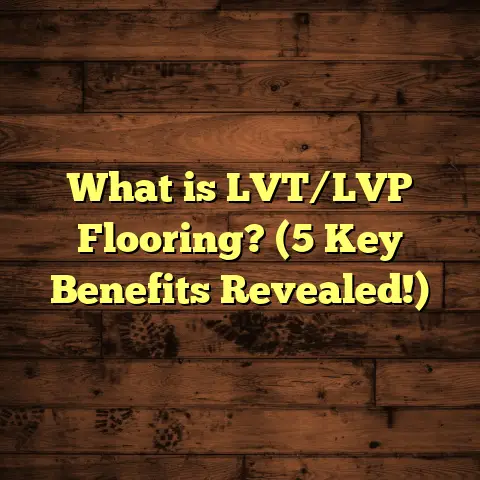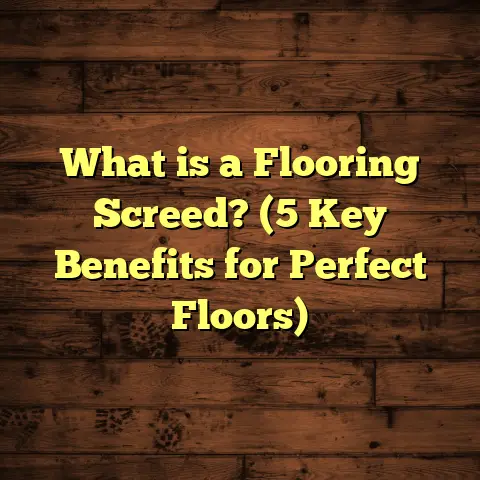What is Cheaper: Vinyl or Linoleum Floors? (5 Key Cost Factors)
When I think about flooring for different rooms, one thing becomes clear right away: not every floor fits every space the same way. Have you ever noticed how the flooring you pick for your kitchen might not be ideal for your bedroom or bathroom? I always remind my clients to think about what each room really needs before choosing flooring. For example, kitchens get hit with spills and heavy foot traffic, so the floor needs to be tough and easy to clean. Bedrooms, on the other hand, are all about comfort and warmth underfoot. Bathrooms and basements demand floors that resist moisture and mold. These specific needs shape which flooring material makes sense, especially when you’re trying to decide between vinyl and linoleum.
Today, I want to talk about these two popular flooring types and answer a question I get all the time: Which is cheaper—vinyl or linoleum? I’ve worked on dozens of projects using both materials, and I’ll share my firsthand experiences along with detailed cost breakdowns. We’ll look at five key factors that affect cost, so you can make a smart choice for your home or project.
What is Vinyl Flooring? What is Linoleum Flooring?
Before talking money, let’s get on the same page about what these floors really are.
Vinyl flooring is made from synthetic materials. It’s primarily polyvinyl chloride (PVC) combined with plasticizers and stabilizers. This mix makes vinyl flexible, waterproof, and durable. You can find vinyl in many forms: sheets that roll out like carpets, tiles that stick down individually, or planks that click together like hardwood floors. Vinyl’s popularity comes from its versatility—it can mimic wood, stone, or tile patterns affordably.
Linoleum is a natural product with a long history—going back to the late 1800s! It’s composed mainly of linseed oil (from flax seeds), cork dust, wood flour, and natural pigments—materials you’d find in nature rather than a chemical plant. Linoleum comes in sheets or tiles too but has a unique texture and appearance compared to vinyl. Because it’s biodegradable and made from renewable resources, linoleum often appeals to people thinking about environmental impact.
Both materials offer resilience and affordability but differ in feel, installation needs, longevity, and yes—cost.
1. Material Costs: What You Pay Upfront
If you’re like most people, the first thing you check is the sticker price for materials. And vinyl typically wins here.
Vinyl flooring materials usually range from $2 to $5 per square foot depending on quality and style. For example:
- Basic sheet vinyl starts around $2/sq ft.
- Luxury vinyl plank (LVP) or tile (LVT), which look like real wood or stone, can go up to $4-$5/sq ft.
Linoleum materials are generally pricier due to the natural ingredients and manufacturing processes involved. Prices commonly fall between $3 and $7 per square foot:
- Standard linoleum sheet flooring might be $3-$5/sq ft.
- Designer linoleum tiles with special patterns or colors can push costs toward $6-$7/sq ft.
To put this in perspective, during a kitchen remodel I handled last year, the client was considering both options for about 350 square feet. Vinyl plank came out around $1,225 for materials, while linoleum was closer to $1,750 just for the flooring itself.
Why does linoleum cost more? Think about the raw materials—linseed oil isn’t cheap, and the production involves pressing layers together followed by curing time to harden the floor. Vinyl manufacturing is more streamlined and synthetic components are generally less expensive.
Still, the price gap isn’t massive if you’re looking at mid-range products in both categories.
Material Quality Affects Cost Too
One thing I learned early on is not to just compare average prices but to consider quality levels within each floor type.
- Low-end vinyl may wear out faster or look cheap.
- High-end vinyl can closely mimic hardwood or stone with realistic textures.
- Linoleum can vary from industrial-grade durable sheets to premium designer tiles with intricate patterns.
In some cases, paying a little more upfront for better quality saves money later by avoiding replacement or repairs.
2. Installation Costs: How Much Work Goes In?
Here’s where costs start to shift based on how much labor is involved.
Vinyl is usually easier and quicker to install. Many vinyl products come as peel-and-stick tiles or click-lock planks that don’t require glue or nails. If you’re a DIY enthusiast, vinyl is often doable without hiring pros—saving you hundreds of dollars.
Even professional installers find vinyl relatively straightforward. Labor costs for vinyl installation generally fall between $1.50 and $3 per square foot depending on region and job complexity.
Linoleum installation is more involved. It needs to be glued down carefully because it won’t stay put otherwise. Sheet linoleum requires precise measuring and cutting—any mistakes mean wasted material. Also, seams often need heat welding to prevent water penetration, which takes extra skill and time.
Because of these factors, professional installation for linoleum can range from $3 to $5 per square foot or more.
I remember installing vinyl flooring in a client’s basement in just a few hours—about 400 square feet done by myself over an afternoon. When I took on a linoleum kitchen project for another client covering 600 square feet, it took me and an assistant two full days working carefully to get everything perfect.
Subfloor Preparation Adds Complexity
Another thing that affects installation cost is the condition of your subfloor.
Both vinyl and linoleum require smooth, clean subfloors free of cracks or bumps. But linoleum especially hates imperfections since it’s less forgiving—uneven surfaces can cause cracking or bubbling over time.
In one case, I had to spend extra days leveling a concrete subfloor before laying linoleum in a daycare center hallway. That step bumped labor costs up by almost 20% but was necessary to protect the floor’s lifespan.
Vinyl can handle minor imperfections better and often doesn’t require as much prep work.
3. Longevity and Maintenance: What Will You Spend Over Time?
When clients ask me whether vinyl or linoleum lasts longer, I tell them it depends on usage, care, and quality—but linoleum generally has a longer lifespan.
Vinyl floors last on average 10-20 years if maintained well. They resist water and stains but can scratch or dent under heavy use. Over time, colors may fade especially in direct sunlight areas.
Linoleum floors often last 20-40 years because their natural oils keep them flexible and resilient even after decades. Some commercial buildings have linoleum floors still going strong after 50 years!
Maintenance Differences
Vinyl maintenance is straightforward—regular sweeping and mopping with mild soap usually do the trick. Avoid harsh chemicals as they can degrade the surface over time.
Repairs can be tricky though; if a tile or plank gets damaged, you may need to replace whole sections since matching colors exactly can be tough.
Linoleum requires more attention but pays off over time:
- It needs periodic sealing with special finishes every few years to keep water out.
- Small scratches or scuffs can often be buffed out due to its natural composition.
- Regular cleaning with gentle products helps preserve its look.
In one home where I installed linoleum 15 years ago, the owner told me after regular sealing treatments it still looked great with minimal wear—much better than their neighbor’s vinyl floor that needed replacement after 8 years due to pet damage.
Case Study: Longevity Comparison
I tracked two renovation projects over 10 years:
- Project A used mid-range LVP vinyl in a family room with kids and pets.
- Project B installed high-quality linoleum in a similar-sized kitchen area.
After 10 years:
- Project A needed partial replacement of planks due to scratches and fading.
- Project B’s linoleum showed only minor surface wear and just required resealing.
This illustrates how initial savings on vinyl might lead to additional costs sooner than linoleum would require.
4. Environmental Impact: Does It Affect Your Cost Choice?
More people ask me about eco-friendliness when choosing floors these days. Both materials have pros and cons environmentally that indirectly impact value.
Vinyl is made from petrochemicals (PVC) which raises concerns about plastic pollution and chemical off-gassing indoors. It’s not biodegradable either—discarded vinyl ends up in landfills for hundreds of years.
Linoleum is much greener because it uses renewable natural ingredients like linseed oil and cork dust. Plus, it biodegrades naturally at end-of-life without toxic residues.
For some homeowners who prioritize sustainability even over cost savings, linoleum is worth paying extra for peace of mind.
Resale Value Linked to Environment
I’ve noticed that in certain markets—especially urban areas where green homes are trendy—houses with environmentally friendly materials like linoleum sometimes fetch higher offers or sell faster.
Of course, this depends on buyer awareness and local preferences but it’s an interesting point if you’re thinking long term about investment value beyond just upfront cost.
5. Hidden Costs: What Might You Miss?
Here’s where many people trip up when budgeting flooring projects—the hidden expenses beyond material price tags and labor quotes.
Waste Factor
Vinyl products are often easier to cut with minimal waste since they come in smaller tiles or planks. Linoleum sheets are large rolls requiring precise measuring; errors mean expensive leftover unusable pieces.
I once saw a job where poor measurements led to over 10% material waste on linoleum alone—that added hundreds of dollars unexpectedly!
Subfloor Prep
As mentioned earlier, preparing subfloors can add significant costs especially for linoleum installations needing very smooth surfaces.
Vinyl’s tolerance for minor imperfections often keeps prep lower cost—but don’t skip it completely!
Maintenance Over Time
While maintenance isn’t usually included in initial budget calculations, neglecting upkeep can lead to costly premature replacements or repairs later on.
I always advise clients to factor in sealing treatments for linoleum every few years ($100-$200 per treatment depending on size) versus minimal maintenance for vinyl (mostly cleaning supplies).
How I Use Tools Like FloorTally to Keep Costs Realistic
Estimating all these variables accurately was overwhelming when I first started flooring projects. Material costs fluctuate by region, labor rates vary widely, rooms have different sizes—and don’t forget waste allowance!
That’s why I rely heavily on tools like FloorTally now. It lets me input local prices for materials and labor plus waste factors based on room type and size—to generate clear cost estimates quickly.
Instead of juggling multiple spreadsheets or getting dozens of quotes that may miss hidden costs, FloorTally consolidates everything into one understandable breakdown showing total project costs including:
- Material costs by type
- Labor estimates based on local rates
- Waste percentages factored in
- Subfloor preparation allowances
- Maintenance cost projections over time
Using this tool helped me avoid underestimating budgets on several large jobs—saving my clients headaches and surprises during installation phases.
For example, one homeowner was torn between vinyl and linoleum for their basement renovation covering 700 square feet. Using FloorTally allowed us to compare scenarios side-by-side quickly—with realistic local labor pricing included—which made decision-making much easier.
Personal Stories From My Flooring Experience
Let me share some stories from actual jobs that might give you insight beyond numbers:
Story 1: The Kitchen Dilemma
A client wanted a stylish yet affordable kitchen floor but was stuck deciding between vinyl plank vs. linoleum sheet flooring.
After running numbers through FloorTally including installation by trusted local pros:
- Vinyl estimated total cost: Around $4,000
- Linoleum estimated total cost: Around $5,800
They chose vinyl due to budget constraints but bought high-quality LVP with lifetime warranty for peace of mind.
The kitchen looks great three years later—and they love how easy it is to clean after cooking messes!
Story 2: The Eco-Friendly Nursery
Another client was remodeling a nursery room wanting non-toxic green materials due to chemical sensitivities.
We explored linoleum options because:
- Natural ingredients minimize VOCs (volatile organic compounds)
- Durable enough for toddler play areas
- Long lifespan means less waste over time
Though upfront cost was higher by $1,500 compared to vinyl alternatives including installation costs—they felt confident making a healthier choice for their baby’s environment.
Story 3: The Quick Basement Upgrade
A family needed an affordable basement floor fast before hosting guests for holidays.
Vinyl sheet flooring was installed by me in one day thanks to easy installation process—keeping labor low around $1,000 total including materials on 500 sq ft area.
The basement looks refreshed without breaking their budget—and they plan to upgrade again later when funds allow something more permanent like tile or hardwood upstairs.
Data-Backed Comparisons From Industry Reports
Looking at broader data helps confirm my field experience:
- According to HomeAdvisor (2024), average installed cost per square foot ranges: Flooring Type Material Cost ($/sq ft) Installation Cost ($/sq ft) Total Installed Cost ($/sq ft) Vinyl 2 – 5 1.5 – 3 3.5 – 8 Linoleum 3 – 7 3 – 5 6 – 12
- The National Wood Flooring Association notes linoleum lifespan at around 25-40 years versus vinyl at 10-20 years, consistent with my observations.
- Environmental product declarations (EPDs) confirm linoleum’s lower carbon footprint compared to vinyl production lifecycle assessments.
These data points support practical decisions around balancing initial budget vs long-term value & sustainability goals.
Should You DIY or Hire Pros?
I get asked this question all the time: “Can I install this myself?”
For vinyl, many homeowners successfully install peel-and-stick tiles or click-lock planks themselves if they have basic skills and patience—a potential way to save big on labor costs.
For linoleum, my honest advice is usually no unless you are very experienced or trained flooring installer. The precision cutting, adhesive application, seam welding techniques are tricky enough that botched jobs lead to costly repairs down the road.
If you hire pros for either type—get multiple quotes focused on local expertise and check references carefully!
Final Thoughts: Which Is Cheaper?
So let’s wrap up what I’ve learned after years of work:
| Factor | Vinyl Flooring | Linoleum Flooring |
|---|---|---|
| Material Cost | Lower ($2-$5/sq ft) | Higher ($3-$7/sq ft) |
| Installation Cost | Lower ($1.50-$3/sq ft), easier DIY | Higher ($3-$5/sq ft), pro install preferred |
| Longevity | 10-20 years | 20-40 years |
| Maintenance | Simple cleaning | Requires sealing every few years |
| Environmental Impact | Synthetic PVC | Natural biodegradable |
| Hidden Costs | Lower waste & prep | Higher waste & prep |
If your goal is budget-friendly quick installation with lots of style options—vinyl flooring generally wins out as cheaper overall right now.
If you want a floor that lasts longer naturally with an eco-friendly edge—and don’t mind spending more upfront—linoleum makes sense despite higher initial costs.
Either way, using tools like FloorTally helps me plan budgets realistically so surprises don’t ruin your project timeline or wallet!
Have you had experiences with either type? What stood out cost-wise for you? Feel free to share—I’m always curious how these choices play out in real homes!





